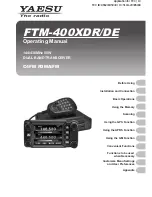
NHM-8NX
Troubleshooting Instructions
PAMS Technical Documentation
Page 4
ã
Nokia Corporation
Issue 1 05/02
Transceiver Troubleshooting
Troubleshooting steps
The following hints should help to find the cause of the problem when the circuitry
seems to be faulty. This trouble shooting instruction is divided into sections.
1 Phone is totally dead
2 Power does not stay on or the phone is jammed
3 Flash programming does not work
4 Display is not working
5 Plug in SIM card is out of order (insert SIM card).
6 Audio fault
7 Charging fault
The first thing to do is carry out a through visual check of the module. Ensure in particu-
lar that:
a) there are no mechanical damages
b) soldered joints are OK.
General instructions
Most semiconductors are static discharge sensitive! ESD protection must be taken care
of during repair (ground straps and ESD soldering irons). Mjoelner, PA, UEM, UPP, and
Flash are moisture sensitive and must be pre-baked prior to soldering, if they have been
out of their vacuum package longer than the specified time.
• Connect test jig (MJS-37) to computer with DAU-9S cable or to FPS-8 Flash
Prommer with AXS-4 serial cable.
• Make sure that you have PKD-1 dongle connected to computer’s parallel port.
• Connect DC power supply to module test jig (MJS-37) with FLC-2 cable.
• Set the MJS-37 supply voltage to 8-12V
DC
. If the input-voltage exceeds 12V
DC
,
the MJS-37 jig may be damaged.
Note: By default the MJS-37 supplies the phone with 4.1V
DC
. If other output voltages is
needed, it is possible to modify MJS-37 to support this by removing R110 and mount S104.
See MJS-37 schematic for more info.
• When doing BB energy management (EM) calibrations use JBV-1 jig and DC sup-
ply voltage 12 – 15 V.
• JBV-1’s current consumption is ~ 40 mA with 3.9 V supply voltage and ~ 80
mA with 15 V supply voltage.
• Set the phone module to test jig (MJS-37) and start Phoenix service software.
Initialize connection to phone (use FBUS driver when using DAU-9S and COM-
BOX driver when using FPS-8).





































